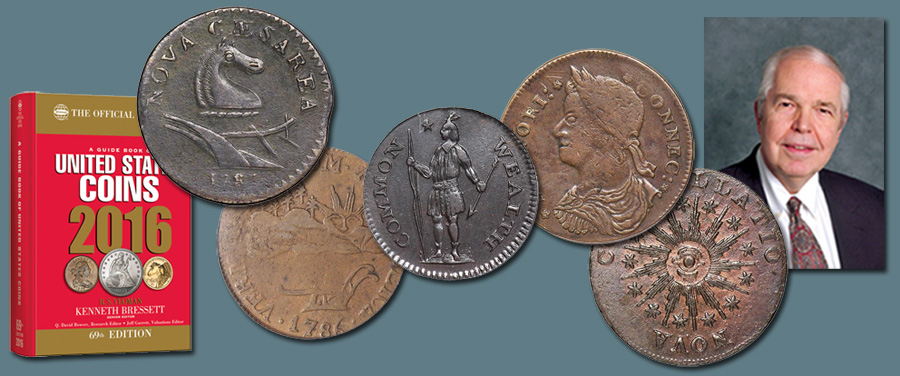
Welcome to the latest and final installment in my series relating to colonial and early American coins in the Guide Book of United States Coins. This week I discuss copper issues beginning on page 54 of the 2016 edition. While there are rarities scattered among the Nova Constellatio coppers, the coins of the states, and other issues, the vast majority of basic types are quite inexpensive and forming a collection can be interesting to do.
The Nova Constellatio coppers dated 1783 and 1785 were made in England, imported to America, and widely distributed here. Today they are all affordable except the 1786. That coin is anomalous and is actually a contemporary counterfeit, so if you do not include one in your set you can still be complete.
Continuing to Immune Columbia coppers, these range from scarce to rare. On page 55 in the middle you will see a listing for one of these with a Vermont obverse. If you turn to page 71 at the top you will see that same coin illustrated, and then on page 72 among Vermont coppers you will see it listed again — perhaps the only instance of the same coin being listed twice in the Guide Book.
Among coinage of the states, the Massachusetts cents and half cents on page 59 are popular and collectible with dozens of different die varieties. A basic set is easy enough to assemble, except for the rare 1787 with the arrows in the right talon (viewed left on the coin) of the eagle, of which only a few dozen exist.
Connecticut coppers, which follow in the Guide Book are the most varied series, with several hundred varieties known. The basic types are interesting to collect, mostly inexpensive in grades of VG to VF, and play to a wide audience. Immersing yourself in the field of Connecticut coppers is a very pleasant pursuit that has been enjoyed by quite a few numismatists over the years.
The copper coinage of New York includes many scarce and rare pieces. The readily available issues are those listed at the top of page 68. These can be collected by the four types listed. A subculture has arisen to collect counterfeit coins made by Machin’s Mills in Newburgh, New York, delineated on page 67. Most of these are inexpensive. Coppers of New Jersey from 1786 to 1788 follow, and again are best collected by types. Most are readily available. My favorite series among such issues are the coppers of Vermont, actually not a state at the time, but the Republic of Vermont, an independent entity that had hoped to join the Union, but border disputes with New York prevented this. It was not until 1791 that Vermont became the 14th star on the flag. Miscellaneous copper issues follow in the Guide Book, all fascinating to study and collect.
To enhance your enjoyment join the Colonial Coin Collectors Club, nicknamed C4. Founded by Mike Hodder in 1993, the organization has grown by leaps and bounds. From their website:
“The Colonial Coin Collectors Club (C4) was founded in 1993 to provide a forum for collectors of numismatic material related to the Early American era. This involves coins, tokens, currency, and medals. The exact time frame encompassed by colonial numismatics is open to debate, but is generally accepted to include the complete pre-federal period as well as some issues of the 1790s. The early George Washington coins, tokens and medals are considered colonial items by most, and some of these date to the first half of the nineteenth century.
“The club provides a forum for people interested in this period. The aims of the club are:
“1- To increase the public’s knowledge about colonial numismatics through meetings, conventions and its newsletter.
“2- To promote the study of colonial numismatics and to help disseminate this information.
“3- To cultivate fraternal collector relations.
“For these purposes, the club will hold several meetings during the year in conjunction with major numismatic shows. The club has also established a colonial reference library and a colonial coin photo file. In addition, the C4 Newsletter is published quarterly.”
The dues are only $30 per year. What a great investment in enjoyment and information!
Next week: Tokens and medals of George Washington.





